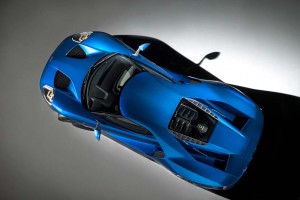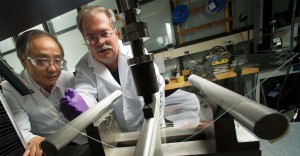When it comes to attacking weight, Ford plans to use some guerilla tactics. Make that “gorilla,” as in Gorilla Glass.
The new Ford GT supercar will become the first vehicle to use a special, multi-layer version of the high-strength glass initially developed by Corning for the consumer electronics industry. It is widely used for smartphones like the new iPhone 6S.
The automotive version of Gorilla Glass is both thinner and significantly lighter, Ford says, but it retains its strength without sacrificing the safety and noise reducing properties of traditional automotive windshield glass.
“Gorilla Glass hybrid is a great example of how Ford works with suppliers to innovate in every area of our business,” said Hau Thai-Tang, Ford’s global purchasing chief. “Ford GT is setting new standards for innovation through performance and light-weighting, and we’re excited about exploring other applications for this great new technology.”
When it comes to the automobile, mass is a major problem. It reduces both fuel economy and performance, something that’s a particularly big problem when it comes to a supercar like the new Ford GT. Manufacturers often go to great pains to trim even a few grams of mass, but Ford expects to save more than 12 pounds by using the Gorilla Glass hybrid for its windshield, bulkhead and transparent engine cover.
(Ford to begin testing autonomous Fusion prototype on California roads. Click Here for the story.)
Conventional windshields use a three-layer matrix — two layers of annealed glass sandwiched around a clear, thermoplastic interlayer — to minimize breakage, reduce noise and yet shatter in ways less likely to injure occupants in the event of a crash.
The Gorilla Glass hybrid uses a multilayer approach, with a toughened automotive-grade polymer, as well as a noise-absorbing thermoplastic sandwiched between Corning glass.
“During development, we tried different glass variations before we found a combination that provided both weight savings and the durability needed for exterior automotive glass,” said Paul Linden, Ford’s body exteriors engineer. “We learned, somewhat counterintuitively, that the strengthened interior layer of the windshield is key to the success of the hybrid window.”
(Ford gets Petty with 727-hp Mustang GT. Click Here to check out the King Edition.)
The new glass is not only 32% lighter than conventional automotive glass, but as much as 50% thinner. Where traditional windshields are up to six millimeters – about a quarter-inch – thick, the new Gorilla Glass hybrid is three to four millimeters, yet it offers comparable strength, and is more robust in resisting stone chipping and other problems, the partners claim.
A simpler, single-layer Gorilla Glass, similar to that used in smartphones, was introduced on the BMW i8. But this is the first application of a multi-layer hybrid, and it will go into production on the 2017 Ford GT.
Ford and Corning aren’t discussing costs but, as with smartphones, Gorilla Glass is believed to be a fair bit more expensive than conventional automotive glass. That’s likely to matter little to Ford GT buyers who will be paying about $400,000 for the new supercar – roughly in line with a Lamborghini Aventador. For them, the reduction in mass and slight improvement in performance is likely to matter far more.
It remains to be seen if Ford and other makers will adopt the Gorilla Glass formula for other vehicles, but with tough new mileage and emissions standards going into place around the world, the push for lightweighting could overcome cost issues on even more mainstream products.
(Ford explores car-sharing, “multi-modal” alternatives. Click Here for the story.)


